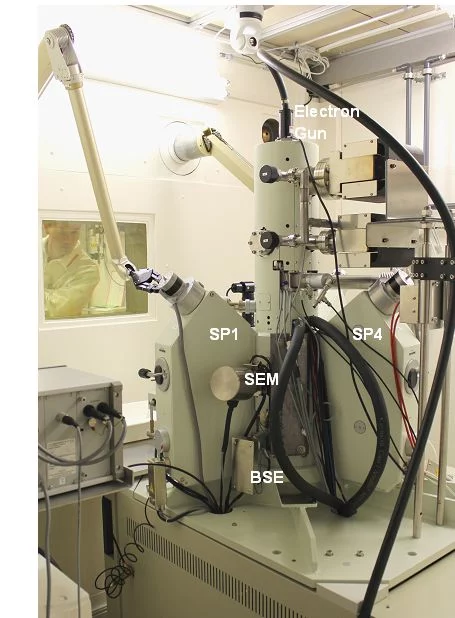The EPMA is an instrument for high resolution surface examination of solid materials and deploys two detection methods from the interaction of a high-energy electron beam with the specimen – High magnification surface imaging and quantitative point analysis of elemental composition
specified as follows:
Scanning Electron Microscopy (SEM)
- Surface beam scanning with detection of secondary electrons (photographic electron image of the surface).
- Topography and morphology imaging of specimens at magnification from 40 to 100’000 times with a large field of depth.
- Backscattered electron detector (BSE) for compositional phase contrast.
X-ray Microanalysis with Wavelength Dispersive Spectroscopy (WDS)
- Quantitative elemental analysis of polished surfaces in a micro area of typically 0.2 to 2 µm³ down to element concentrations of 0.1 wt% (detection limit about 100 ppm) by measuring the emission of X-rays from the excited state of atoms.
- Analysis area up to diameter 60 µm by beam defocusing.
- Element distribution mappings of surfaces by beam and stage scanning.
Instrument
- JEOL 8500F with field emission gun (FEG) of high brightness and small electron beam diameter.
- High energy electron beam (1-30 keV) and current of 0.01 – 500 nA.
- The instrument is situated in a lead shielded cabin separated from the control desk.
- Massive internal tungsten shielding for the protection of the X-ray count detectors to measure also highly radioactive specimens.
- Four X-ray spectrometers (SP1 – SP4), two with PET/LIF analysing crystals, LD1/TAP and LD2/TAP for light elements.
- Two specimen holders for sample size up to 1¼-inch: A shielded holder for quantitative analysis and a holder for the tilt and rotary stage (e.g. fractography).
Scope
- SEM- and BSE microscopic imaging of surfaces.
- Elemental quantitative X-ray analysis (point analysis, line scan).
- Qualitative and semi-quantitative elemental mapping at high magnification (local beam scanning) or larger area stage scanning (up to 20 x 20 mm²).


